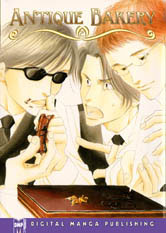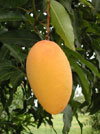|
|
 |
Until recently, I thought manga was something barefoot arts school vegans ate when the organic fruit store was out of papaya. Now, I’m fully aware that it’s a backwards comic laced with surprisingly lewd sexual innuendo. I've always thought Japanese culture to be impenetrable to anyone without either an import-tuned Honda or an advanced Asian studies degree, and their pop culture seems doubly so. Therefore, I never tried manga, despite the fact that all the cool kids were doing it. And by ‘cool kids’, of course I mean the kids whose parents wouldn’t let them play Dungeons & Dragons, because the dice were pointy and the spells were Satanic. My experience with anime was also somewhat limited, having barely skimmed the surface with Akira, Spirited Away, and several dozen half-hour shorts downloaded from Hentai sites featuring tentacles and non-consensual sex with schoolgirls. So, I was intimidated, fearful, but yet mildly excited at the prospect of leaping into Antique Bakery 2, my very first manga.
 Not the right kind of Manga |
I probably shouldn’t have started with #2. Not that it matters, story-wise, given that Antique Bakery doesn’t seem to have a real sense of continuity, but I probably would have been better served by a number 1, in terms of tackling some of the unfamiliar story-telling techniques found in this, and possibly all, manga. First of all, manga is read back to front, like the Torah, or those dirty flip books I used to make out of the science textbooks in high school, where Newton’s 3rd Law of Motion was crudely illustrated by two big breasted stick figures and a Labrador retriever. Secondly, there’s a whole different set of visual and symbolic cues that are culturally specific, and therefore confusing and weird to neophyte North Americans. Apparently, in manga, it’s no big deal for the artistic style to change depending on character’s emotional state. Most of the time, Antique Bakery 2 is drawn in the standard angular, androgynous, but realistic style familiar to fans of anime. But every once in a while, when somebody gets angry or agitated, everything will shift to look like Pokemon trading cards, with big eyes and gaping mouths, like Powerpuff Girls about to yell. And then, when the crisis has passed, it’s back to lanky, triangle-faced men with figures like Kate Moss with fewer curves.
 Also not the right kind of Manga. But closer |
As for Antique Bakery itself, well, it’s a strange introduction to the world of manga. For starters, it’s a yaoi, which as I understand it, is a sub-genre of manga written by women for teenage girls, dealing exclusively in male homosexual titillation, like the male version of Xena: Warrior Princess. In essence, it’s like slash fiction, or Wild Things, except instead of anything actually happening, there’s a lot of dancing in the rain and guys getting custard on their faces after biting into a sponge cake. So, if you’re the kind of person who gets their crank turned by a Backstreet Boys video set in a bakery, and you like to read backwards, then Antique Bakery 2 may be the manga for you. As for myself, the thinly veiled homoeroticism did little but remind me of any heavy metal concert or high school football movie, and the story itself let me down. Antique Bakery is light, fluffy and disposable; not much more than a collection of geographically linked anecdotes, the book has little in the way of a gripping story. Essentially, the comic is a story of the titular bakery, where the aggressively hetero owner Tachibana is having a hard time fighting off the advances of his gay head pastry chef Ono, who is possessed of “Gay Demonic Charm”. Meanwhile, the sous-chef is a part time boxer, a plot conceit that is little more than an excuse for him to potentially take his shirt off and sweat. A tall, dark, handsome stranger in Cory Hart sunglasses shows up, but instead of providing conflict and tension, all he does is motivate a lot of confusingly childish courtship. I’m not an expert on gay culture by any means, but I do live in a cosmopolitan and open-minded city, and I’ve seen Lord of the Rings, so I’m fairly sure that most adult homosexual relationships play out less like the Sweet Valley High romance seen here, and involve more dripping sweat on the floor of the men’s room in a nightclub on 80s night. Actually, the same could probably be said about hetero relationships. Regardless, the story lacks anything more than a chronological progression, and is missing any real dramatic or character development. The book ends with a series of illustrated recipes, but as I’m firmly convinced that Japanese cuisine consists mainly of covering perfectly good food with rice vinegar, I didn’t pay them much mind. The art is effective and clear, consisting of a traditional angular style, but some of the story telling seems off-putting. Jumps in chronology come abruptly and without warning, and there are plenty of annoying interjections by a snide narrator. I assume they’re meant to be light-hearted and comic, but they just come off like someone’s little brother wrote in the margins of your old issues of Heavy Metal Magazine. While I didn’t hate the book at all, I can’t really see why it won the coveted Kodansha award, unless the competition involves knocking another hefty manga out of a rice bale circle. I’ll look into that, hopefully in time for my second manga.
Rating: 5 out of 10 stars.
Email the author.
© Copyright 2002-2019 by Toon Doctor Inc. - All rights Reserved. All other texts, images, characters and trademarks are copyright their respective owners. Use of material in this document (including reproduction, modification, distribution, electronic transmission or republication) without prior written permission is strictly prohibited.

